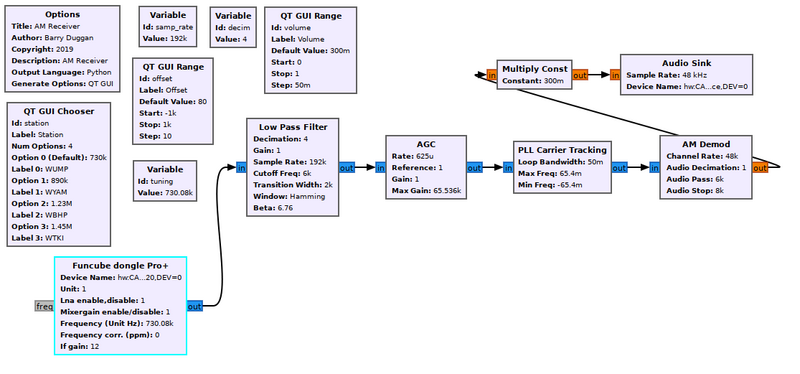AM Demod: Difference between revisions
Jump to navigation
Jump to search
m (removed note about sample rate. By definition it is a float, but traditionally is specified without a decimal point with no ill effect.) |
m (moved note from Example Flowgraph to intro section) |
||
| (One intermediate revision by the same user not shown) | |||
| Line 3: | Line 3: | ||
This block demodulates a band-limited, complex down-converted AM channel into the the original baseband signal, applying low pass filtering to the audio output. It produces a float stream in the range [-1.0, +1.0]. | This block demodulates a band-limited, complex down-converted AM channel into the the original baseband signal, applying low pass filtering to the audio output. It produces a float stream in the range [-1.0, +1.0]. | ||
Note: The AM Demod block is the same as a Complex to Mag block feeding an Add Const block feeding a Low Pass Filter. See [[Complex_to_Mag#Example_Flowgraph]]. | |||
== Parameters == | == Parameters == | ||
Latest revision as of 00:15, 27 October 2019
Generalized AM demodulation hierarchical block with audio filtering.
This block demodulates a band-limited, complex down-converted AM channel into the the original baseband signal, applying low pass filtering to the audio output. It produces a float stream in the range [-1.0, +1.0].
Note: The AM Demod block is the same as a Complex to Mag block feeding an Add Const block feeding a Low Pass Filter. See Complex_to_Mag#Example_Flowgraph.
Parameters
(R): Run-time adjustable
- Channel rate
- Incoming sample rate of the AM baseband
- Audio decimation
- Input to output decimation rate
- Audio pass
- Audio low pass filter passband frequency
- Audio stop
- Audio low pass filter stop frequency
Example Flowgraph
This flowgraph shows the use of an AM Demod block to implement an AM broadcast receiver.
Source Files
- Python file
- Here
- Block definition
- TODO
